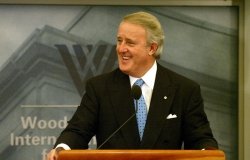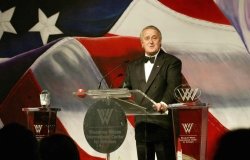Book Launch: <i>Lift Every Voice: The NAACP and the Making of the Civil Rights Movement</i>
Author Patricia Sullivan, Associate Professor of History and African-American History, University of South Carolina and Former Fellow, Wilson Center; Julian Bond, Professor of History, University of Virginia (commentator); Kenneth Mack, Professor of Law, Harvard Law School, (commentator)
Overview
Author Patricia Sullivan, associate professor of history and African-American studies, University of South Carolina; commentator Julian Bond, professor of history, University of Virginia, and board chair, NAACP; and commentator Kenneth Mack, professor of law, Harvard Law School.
The oldest civil rights organization in the United States, the National Association for the Advancement of Colored People is currently celebrating its 100th anniversary. On its centennial Constitution Day, civil rights scholars and activists gathered at the Wilson Center to celebrate the publication of Patricia Sullivan's new history of the organization, Lift Every Voice: The NAACP and the Making of the Civil Rights Movement.
The NAACP was created by a coalition of white and black activists in the wake of a race riot in Springfield, Illinois—the first to occur above the Mason-Dixon Line. Its original mission was to prevent the spread of Jim Crow laws, lynching, and segregation from the South to the North. Many Americans learned about the organization through its monthly magazine The Crisis, whose first editor was the noted scholar W. E. B. Du Bois. Later the NAACP gained fame by winning a number of important legal cases, most notably the landmark Brown v. Board of Education in 1954.
Patricia Sullivan began work on her book as a Wilson Center Fellow and finished it while a Public Policy Scholar. In her presentation, she noted several surprises that emerged from her research. In its early years, the NAACP had little money, she said, and for funding relied mainly upon its predominantly black membership. The publication of The Crisis played a crucial role in this respect, for its reports of developments around the country created a national community for the assertion of civil rights and maintained ties between the organization and its membership.
A crucial turning point came in the mid-1930s. Du Bois resigned after declaring that the organization was not working. He explained in an editorial that segregation in the North was more widespread and firmly entrenched than ever, and he advised African Americans to rely upon their own institutions to advance their interests.
Around that time, the NAACP hired Charles Hamilton Houston as an attorney. Houston implemented a strategy that attacked segregation in the South through aggressive litigation. An important component of this approach was the symbiotic relationship between local chapters and the national organization. The NAACP's headquarters gained important information about civil rights abuses from its membership, but they needed local organizations to enforce legal victories. Otherwise authorities either ignored or circumvented court decisions.
Julian Bond praised Sullivan for completing a task—writing a comprehensive history of the early years of a complex organization--that had eluded many who had previously attempted it. The book, he said, was a necessary corrective against myths surrounding an organization that is still the most favorably viewed civil rights group today. The NAACP continues to be the "go-to organization" to right wrongs against minorities, a mission that includes not only African Americans but all communities of color (hence the use of the word "colored," as opposed to "Negro" or "black"), and its local offices still serve as "triage centers for communities in crisis." Its numerous youth and college chapters demonstrate the organization's ongoing appeal and vitality.
Moreover, Bond asserted, the NAACP's appeal has extended beyond its formal membership. To illustrate, he related a story that former NAACP lawyer Vernon Jordan once told him. While trying a murder case in Georgia, Jordan and his staff had to eat lunch in their cars because the community was so segregated. One day, an audience member secretly directed the team to a picnic area, where they found large amounts of food laid out for them. "We can't join the NAACP" because it was too dangerous, his guide explained, "but at least we can feed the NAACP."
Bond noted that as a student at Morehouse College in Atlanta in the 1960s, he rejected the NAACP because in his mind the organization was associated with the older generation. Instead, he joined the newly-formed Student Non-Violent Coordinating Committee (SNCC). Later, after SNCC had become defunct, Bond returned to the NAACP, devoting himself to the organization and eventually becoming its board chair.
In his comment, Kenneth Mack explained how Sullivan's book had destroyed several "false binaries" that had plagued earlier work on the NAACP. Previous scholarship, he said, had claimed that the organization pursued legal equality at the expense of social and economic justice. According to this interpretation, the NAACP was a top-heavy, middle-class bureaucracy dependent upon white paternalism and out of touch with the population it purported to represent.
Lift Every Voice disproves these criticisms, Mack said, by describing the day-to-day activities of the NAACP's lawyers. Sullivan shows that Houston did not begin with a fully formed legal strategy, but had to improvise. Lawyers traveled to local communities and responded to immediate needs. Organization grew out of litigation—often local chapters started because a lawsuit had been filed. This dynamic showed that there was no conflict between legal struggles and grassroots mobilization, an important lesson for today's civil rights activists.
Written by Michael Easterly
Edited by Sonya Michel
Thank you for your interest in this event. Please send any feedback or questions to our Events staff.










